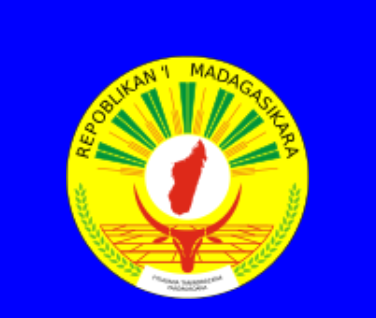sapphires of Madagascar
THE SKY IS ALWAYS BLUER: THE SAPPHIRES OF MADAGASCAR
Since their discovery in 1994, Madagascar has gradually become the world’s largest supplier of high-quality Blue Sapphires at low cost. It seems that not many years go has passed by without another major mines discovery.
This article provides a brief introduction to the beautiful Blue Sapphires of Madagascar, and then moves on to a comprehensive review of their inclusions
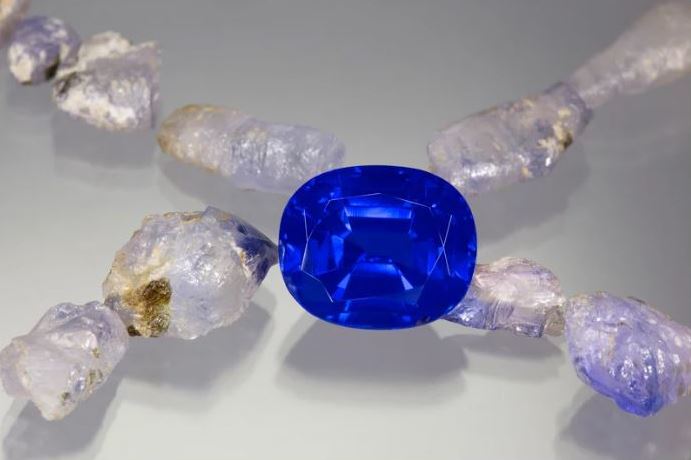
The rough Blue Sapphires in this photo come from India’s famous Kashmir mines, while the 14 cts cut stone comes from Madagascar. Which do you prefer ? A poor-quality Kashmir sapphire or the magnificent blue beauty of Madagascar ?
INTRODUCTION
The island of Madagascar is an anomaly in several ways. Despite lying just 400 Km off the coast of Africa, it was not inhabited until 2,000 years ago, and not by Africans, but by adventurous sailors from the Malay-Indonesian Archipelago, some 6,400 Km to the east. Today, the region’s population is a tumultuous mess spiced with Malay, African, Arabic, French, Chinese and Indian ingredients.
Madagascar has long been recognized as one of the most biologically diverse places on the planet. A few things to add perspective:
- The island, about the size of California, is home to about 4% of the world’s landmass, despite only making up 0.4% of the landmass.
- 80% of the species in Madagascar are endemic, meaning they cannot be found anywhere else on the planet.
- Even though Madagascar only covers about 1.9% of Africa’s land mass, it is home to more orchids than the entire continent. It is home to about 25% of all African plants.
- Nearly 100% of lemur species are found only in Madagascar.
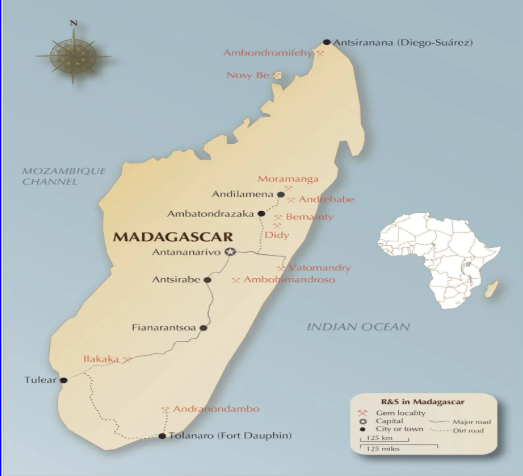
Madagascar owes its biological diversity to its geology. More than 165 million years ago, the island was a landlocked plateau in the centre of the supercontinent, Gondwana. At that time, giant reptiles roamed the Earth, while plants, and birds were making their first appearance. Gondwana then crumbled, leaving Madagascar adrift in the Indian Ocean. Most of the ancient species were left to their fate, to be pollinated by plants, animals, and humans who arrived on the island by flying, drifting, swimming and sailing. The result is a zoo unlike any other on the planet.
WHAT ABOUT MADAGASCAR’S SPECTACULAR GEMOLOGICAL DIVERSITY ?
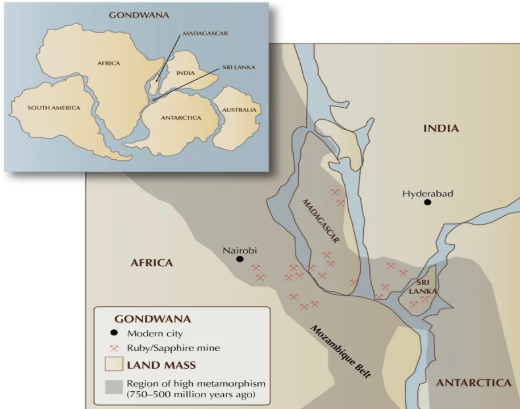
A quick look at the map of Gondwana provides the answer. Before the separation of this landmass, Madagascar’s closest neighbours were East Africa, Southern India, and Sri Lanka. These regions represent some of the richest gem deposits in the world. Madagascar lies in the very centre of gemstone Nirvana.
Map of Gondwana showing the position of Madagascar in relation to East Africa, Sri Lanka and southern India.
The first major discovery of blue sapphires in Madagascar occurred in 1991 at Andranondambo. These were beautiful blue stones that were initially confused
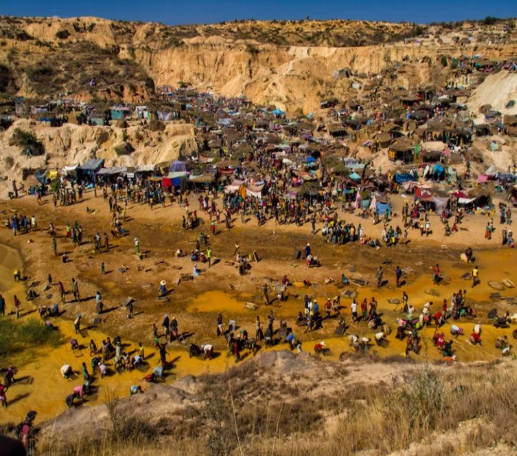
(but still are), with the famous blue gems of Kashmir.
In 1995, dark Blue Sapphires of basaltic origin were mined at Ambondromifehy in the far North. But, the discovery, that really set the gem world alight occurred in 1998, when Sapphires were mined near the small village of Ilakaka. Overnight, the population grew from a few hundred to ten thousand. This was the first great rush for gems in Madagascar, a rush that continues to this day.
Following in the footsteps of Ilakaka, corundum was found at Vatomandry in 2000, at Moramanga, and Andrebabe in 2004, at Didy in 2012, and at Bemainty in 2015. It seems, that wherever you stick your spade in the ground, you have a good chance of extracting a Ruby, or Blue Sapphire.
(Many foreign traders have opened small sales offices in the town of Ilakaka. During market hours miners, and traders go from office to office, displaying their wares. Buying at these markets can be an opportunity for a good deal but also a trap since many rough stones are not worth the money. Rough is like gambling in Vegas, kids.
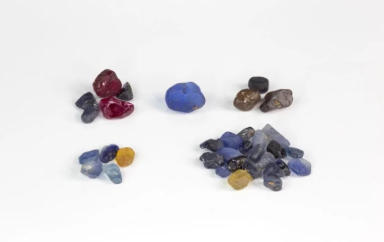
A sampling of stones purchased during a Lotus Gemmology field trip to Ilakaka in 2016. Although we knew that many of these stones were not properly presented for what they were, we purchased them to get a general idea of the local market.
INCLUSIONS
There are many characteristics of Madagascar Blue Sapphire, that, when considered together, can help distinguish these stones from those of other origins.
Here are some of the most notable:
POINTED ANGULAR GROWTH ZONING
One of the distinguishing characteristics of Madagascan Blue Sapphire is the extremely complex angular growth zoning. These zones form pointed angular structures when viewed perpendicular to the C-axis, and are sometimes so close together that they create an iridescent effect.
DEEP BLUE COLOUR ZONES
Colour zoning can be eye-catching, because of its subtlety, and the deep blue surrounded by clouds of milky texture of lighter colour. We can also observe streaks of fine particles, that go against the grain of these colour zones.
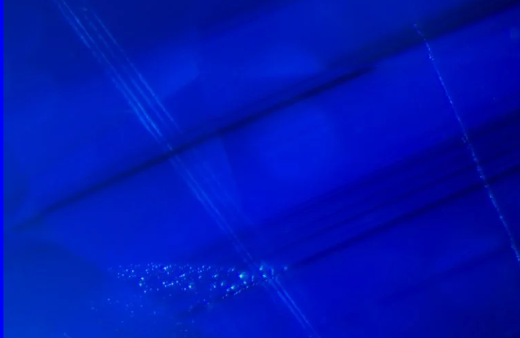
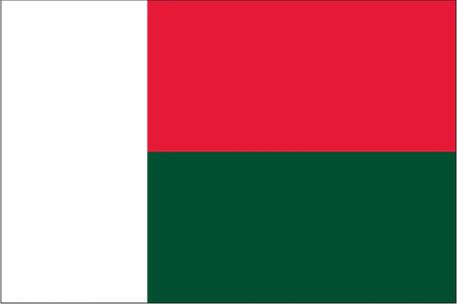
THE POLITICAL SISTUATION
MADAGASCAR FLAG HISTORY
The white is said to stand for purity, and the red for sovereignty; the green represents the coastal regions, and symbolizes hope. Many other former French colonies adopted vertical, or horizontal tricolours, showing clearly the influence of the French Tricolour on their designs, but Madagascar chose a unique arrangement.
During French rule, Malagasy people were required to fulfil corvée labour on French-run plantations while access to education, or skilled positions were limited, although basic services like schools, and clinics were extended across the island. Several militant nationalist secret societies emerged in opposition to French rule, of which the most prominent was Vy Vato Sakelika formed in 1913. Many Malagasy were conscripted to fight for France during the First (1914–1918), and Second World Wars (1939–1945), and during the latter Madagascar came under Vichy French Regime control before being captured by the British in the Battle of Madagascar, and returned to Free French control in 1942. In 1944, Madagascar became an overseas territory with representatives in the French National Assembly. Militant nationalists launched a large uprising in 1947, that was brutally suppressed by 1949.
The country gained full independence from France in 1960. Madagascar’s First Republic (1960–1972), was established as a democratic system modelled on that of France, and led by President Philibert Tsiranana. Popular unrest led to the Socialist Democratic Republic of Madagascar under Admiral Didier Ratsiraka (1975–1992), distinguished by economic isolationism, and political alliances with pro-Soviet states. By 1992, free and fair multiparty elections were held, ushering in the Democratic Third Republic (1992–2009). Under the new Constitution, the Malagasy public elected successive Presidents Albert Zafy, Didier Ratsiraka, and Marc Ravalomanana. This latter was ousted in the 2009 Malagasy political crisis by a popular movement under the leadership of Andry Rajoelina. Elections were held on December 20, 2013, to elect a new President and return the country to constitutional governance.
PIRATES AND SLAVE-TRADERS
Between 1680 and 1725, Madagascar became a Pirate stronghold. Many unfortunate sailors became shipwrecked, and stranded on the island. Those who survived settled down with the natives, or more often, found French or English colonies on the island, or even pirate havens and thus became pirates themselves. One such case, that of Robert Drury, resulted in a journal giving one of the few written depictions of Southern Madagascar, in the 18th Century.
Notable pirates including William Kidd, Henry Every, John Bowen, and Thomas Tew made Antongil Bay, and Île Sainte-Marie (a small island 12 miles off the Northeast coast of Madagascar), their bases of operations. The pirates plundered merchant ships in the Indian Ocean, the Red Sea, and the Persian Gulf. They deprived Europe-bound ships of their silks, cloth, spices, and jewels. Vessels captured going in the opposite direction (to India), lost their coin, gold, and silver. The Pirates robbed the Indian cargo ships that traded between ports in the Indian Ocean as well as ships commissioned by the East India Companies of France, England, and the Netherlands. The pilgrim fleet sailing between Surat in India, and Mocha on the tip of the Arabian Peninsula were a favourite target, because the wealthy Muslim pilgrims often carried jewels, and other finery with them to Mecca. Merchants in India, various ports of Africa, and Réunion showed willingness to fence the Pirates’ stolen goods. The low-paid seamen who manned merchant ships in the Indian Ocean hardly put up a fight, seeing as they had little reason or motivation to risk their lives. The Pirates often recruited crewmen from the ships they plundered.
With regard to piracy in Malagasy waters, note the (semi-)legendary accounts of the alleged Pirate-state of Libertalia.
Prior to the arrival of the Europeans, certain Malagasy tribes occasionally waged wars to capture, and enslave prisoners. They either sold the slaves to Arab traders, or kept them on-hand, as labourers. Following the arrival of European slavers, human slaves became more valuable, and the coastal tribes of Madagascar took to warring with each other to obtain prisoners for the lucrative slave-trade. Instead of spears and cutlasses, the tribesmen fought with muskets, musket-balls, and gunpowder, that they obtained from the Europeans, conducting fierce and brutal wars. On account of their relationship to the pirates, the Betsimisaraka in Eastern Madagascar had more firearms than anyone else. They overpowered their neighbours, the Antankarana and Tsimihety, and even raided the Comoro Islands. As the tribe on the west coast with the most connections to the slave trade, the Sakalava people also had access to guns, and powder.
FIRST ATTEMPTED COUP
Ravalomanana’s Tiako I° Madagasikara party achieved overwhelming electoral success in December 2001, and he survived an attempted Coup in January 2003. He used his mandate to work closely with the IMF, and the World Bank to reform the economy, to end corruption, and to realise the country’s potential. Ratsiraka went on trial (in absentia), for embezzlement (the Authorities, as always, charged him with taking $8m of public money with him into exile), and, the Court sentenced him to ten years’ hard labour.
Ravalomanana is credited with improving the country’s infrastructure, such as roads, along with making improvements in education and health, but has faced criticism for his lack of progress against poverty; purchasing power is said to have declined during his time in office. On 18 November 2006, his plane was forced to divert from Madagascar’s capital during a return trip from Europe following reports of a Coup underway in Antananarivo, and shooting near the airport; however, this alleged Coup attempt was unsuccessful.
Ravalomanana ran for a second term in the presidential election held on December 3, 2006. According to official results, he won the election with 54.79% of the vote in the first round; his best results were in Antananarivo Province, where he received the support of 75.39% of voters. He was sworn in for his second term, on January 19, 2007.
Ravalomanana dissolved the National Assembly in July 2007, prior to the end of its term, following a constitutional referendum earlier in the year. Ravalomanana said, that a new election needed to be held so, that the National Assembly would reflect the changes made in this referendum.
He became involved in a political standoff after he closed the TV station belonging to Antananarivo mayor Andry Rajoelina. In January 2009, protests which then turned violent were organized, and spearheaded by Andry Rajoelina, the mayor of the capital city of Antananarivo, and a prominent opponent of President Ravalomanana.
The situation fundamentally changed on 10 March 2009 when army leaders forced the recently appointed defence secretary to resign (the previous one had decided to resign after the killings by the presidential guard on 7 February 2009). They also announced, that they gave the opponents 72 hours to dialogue, and find a solution to the crisis before they would take further action. This move came after the leaders of the main military camp had announced a day earlier, that they would not execute orders coming from the presidency any more since their duty was to protect the people, and not to oppress them, as groups of the military had done over the last few days.
THE FINAL COUP KIDS
On 16 March 2009, the army seized the presidential palace in the centre of Antananarivo. Ravalomanana was not in the palace at the time. He handed his resignation to the army, which then decided to hand over power to his fierce political rival, Andry Rajoelina. The second round of the postponed presidential elections was held in December 2013, and the results were announced in January 2014. The winner, and the next president was Hery Rajaonarimampianina. He was backed by Rajoelina who led the 2009 Coup, and still was very influential political figure.
In 2018 the first round of the presidential election was held on 7 November, and the second round was held on 10 December. Three former Presidents, and the most recent President were the main candidates of the elections. Former President Andry Rajoelina won the second round of the elections. He was previously President from 2009 to 2014. Former President Marc Ravalomanana lost the second round, and he did not accept the results because of allegations of fraud. Ravalomanana was President from 2002 to 2009. The most recent president Hery Rajaonarimampianina received very modest support in the first round. In January 2019, the High Constitutional Court declared Rajoelina, as the winner of the elections, and the new President.
In November 2023, Andry Rajoelina was re-elected to another term with 58.95% of the vote in the first round of the election. Turnout was 46.36%, the lowest in a presidential election in the country’s history.
As always, being in this business for more then 30 year, we have seen them all, and, of course, we have high ranking “naughty” political friend down there, too. It’s the same old story, down there, in Africa, and, everywhere else, kids !!!
ENJOY.
